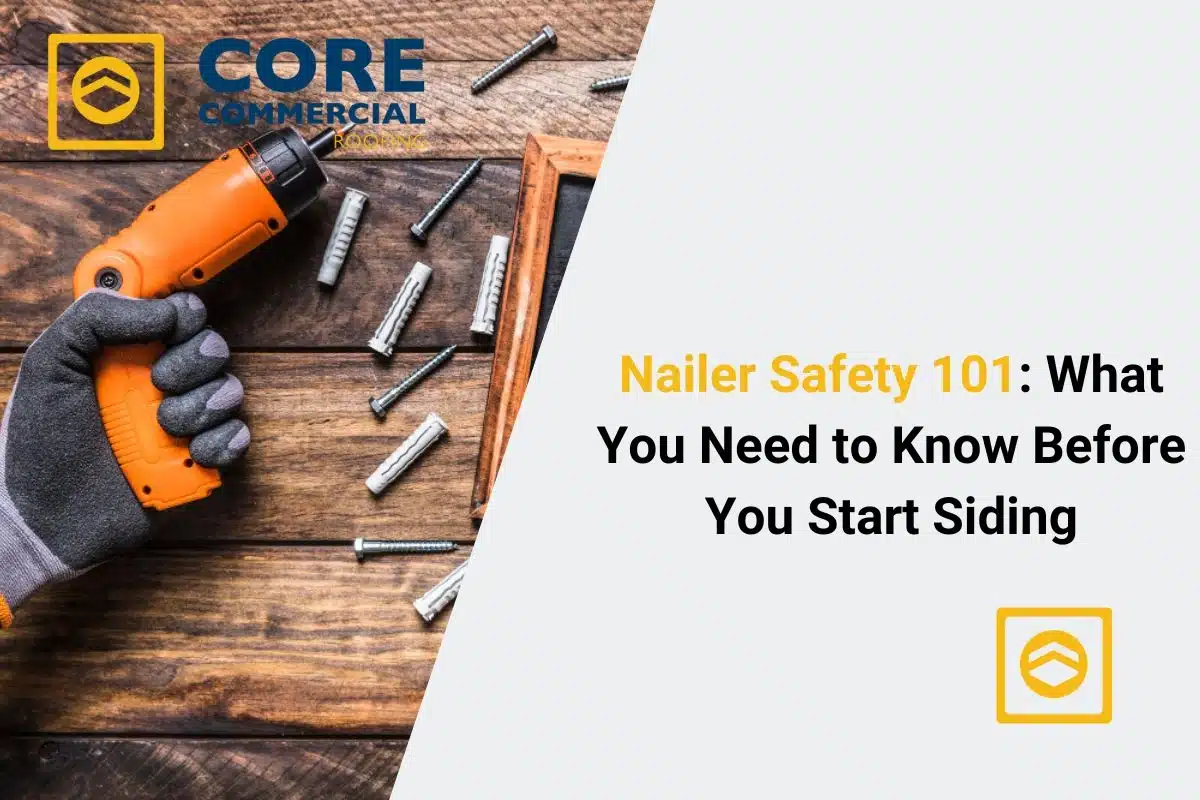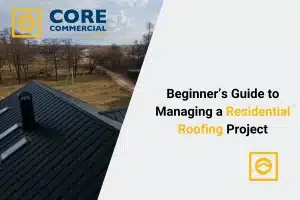Working with a nail gun can speed up siding projects and give professional results, but it also comes with serious risks if safety steps are skipped. Nailers are powerful tools that drive nails with enough force to puncture wood, metal, and even concrete. One of our favorite safety habits to mention right from the start is keeping both hands behind the line of fire. It sounds simple, but this single method prevents many of the most common accidents people face on siding jobs. When you learn how to handle the tool properly, use the right gear, and create a safe workspace, you not only protect yourself but also make your work faster and smoother. This guide to nailer safety will give you everything you need to stay safe, build confidence, and complete your siding project with professional results.
Table of Contents
Why Nailer Safety Matters
Nail guns are among the most common tools used in siding, framing, roofing, and finishing work. Their speed and efficiency make them a favorite, but that power also creates hazards. Every year, thousands of people visit emergency rooms due to nail gun accidents. Many of these injuries are preventable with the right knowledge and habits.
You may learn: commercial roof maintenance
Siding projects often involve working on ladders, handling large boards, and moving quickly. Add a nailer into the mix, and the potential for accidents grows. Nails can ricochet, misfire, or double fire, and it takes only one mistake to cause a serious injury. By focusing on nailer safety, you not only protect your hands and eyes but also reduce downtime, avoid costly medical bills, and ensure your project goes smoothly.
Understanding the Basics of Nail Guns
Before you pick up a nailer, it’s important to understand how it works. Nailers use compressed air, gas, or battery power to drive nails at high speed. Most siding nailers operate on pneumatic systems, meaning they connect to an air compressor.
Key features to know include:
- Trigger type: Some nailers use contact (bump) triggers, which fire when the nose and trigger are pressed at the same time. Others use sequential triggers, requiring a specific order to press the nose and trigger. Sequential triggers are safer for beginners.
- Depth settings: Adjusting depth ensures nails sink correctly into siding without breaking boards or leaving them loose.
- Magazine style: Some nailers use coil magazines that hold many nails, while others use stick magazines. Each has pros and cons depending on project size.
By knowing your tool, you reduce the chance of surprises that could cause accidents.
You should learn: how to install metal roofing
Personal Protective Equipment (PPE) You Should Never Skip
One of the most overlooked parts of siding safety is wearing the right gear. Nailer accidents often involve flying debris, nail ricochets, and loud noise. The right PPE can mean the difference between a close call and a serious injury.
- Safety glasses: Protect your eyes from flying nails, wood splinters, and dust.
- Hearing protection: Nailers and compressors are loud, especially during long siding projects. Earplugs or earmuffs prevent hearing loss.
- Gloves: Choose snug gloves that provide grip without extra bulk. They protect your hands while still allowing control.
- Work boots: Steel or composite toe boots protect feet if nails drop or boards fall during installation.
- Respiratory protection: If you’re cutting siding or working around dust, a mask helps keep your lungs clear.
Taking a few seconds to gear up protects you for the entire day.
Safe Handling Practices for Nailers
Nailer safety depends on how you hold, aim, and fire the tool. Even experienced pros can slip into unsafe habits when rushing.
- Keep hands out of the line of fire: Always position your non-dominant hand away from where the nail exits. Many injuries happen when hands hold boards too close to the nailing spot.
- Never disable safety mechanisms: Some people remove guards to work faster, but this greatly increases accident risks.
- Check surroundings before firing: Make sure no one is behind or under the board you’re nailing. Nails can pass through or miss the target completely.
- Maintain a firm stance: Balance is critical when working on ladders or scaffolding. Don’t overreach with the nailer.
- Keep finger off trigger until ready: Resting your finger on the trigger can cause accidental fires when moving the tool.
These practices may feel slow at first, but they become second nature and help prevent injuries.
Preventing Misfires and Double Fires
A common risk with nailers is a misfire, when the tool jams, or a double fire, when two nails shoot rapidly with one pull. Both issues can create dangerous situations.
To reduce misfires and double fires:
- Use the correct nails recommended for your nailer.
- Keep your air pressure within the tool’s specified range. Too much pressure increases double fire risks.
- Regularly clean and oil your nailer to keep it working smoothly.
- Release the trigger fully between each shot.
- Avoid pressing the nailer nose too hard against the surface, which can cause bounce-back and extra firing.
By maintaining your tool and following proper technique, you minimize these hazards.
You may read: commercial roof leak repair
Creating a Safe Work Area
A nailer is only as safe as the environment you use it in. A cluttered, unstable, or poorly lit work area can turn minor mistakes into major accidents.
- Clear the ground: Remove tools, cords, and scrap siding from walkways to prevent trips.
- Secure boards: Always brace or clamp siding boards before nailing to avoid sudden shifts.
- Use ladders and scaffolds properly: Keep ladders stable and avoid leaning too far. For long siding runs, scaffolding may be safer.
- Maintain good lighting: Shadows can hide nails, gaps, or obstacles.
- Keep bystanders away: Children, pets, or untrained helpers should stay out of the work zone.
The safer your workspace, the more confident and productive you’ll be.
Maintenance and Inspection Before Every Use
Neglecting maintenance is one of the fastest ways to turn a safe nailer into a dangerous one. Before every siding session:
- Check hoses and connections: Look for leaks, cracks, or loose fittings in pneumatic systems.
- Inspect the safety contact tip: Make sure it moves smoothly and isn’t jammed.
- Test the trigger: Ensure it requires the proper sequence and doesn’t stick.
- Examine nails: Bent or incorrect nails can jam the magazine and cause accidents.
- Lubricate the tool: A few drops of oil in pneumatic nailers keep parts moving correctly.
Routine inspections take only a minute but can save hours of frustration and risk.
Common Mistakes Beginners Make
If you’re new to siding, it’s natural to make mistakes. Recognizing the most common ones helps you avoid them.
- Holding the siding too close to the nail point.
- Firing nails without checking what’s behind the board.
- Using contact (bump) firing mode before learning sequential mode.
- Skipping safety gear because it feels uncomfortable.
- Ignoring tool jams and trying to keep firing.
Learning from others’ mistakes keeps your projects safer and less stressful.
Benefits of Practicing Proper Nailer Safety
Nailer safety isn’t just about avoiding accidents. It comes with positive benefits that improve your overall experience:
- Better quality work: Safe handling means nails are placed correctly, reducing siding gaps and loose boards.
- Faster progress: When you avoid jams, double fires, and accidents, the project moves smoothly.
- Peace of mind: Confidence in your safety practices lets you focus on craftsmanship instead of fear.
- Lower costs: Preventing injuries avoids medical expenses and lost work time.
- Longer tool life: Maintenance and correct use reduce wear on your nailer.
These benefits add up to more professional results and greater satisfaction with your siding project.
Final Thoughts
Nailer safety should never be an afterthought. By understanding how nail guns work, wearing the right protective gear, practicing safe handling, and keeping your workspace organized, you create an environment where accidents are far less likely to happen. One of the simplest and most effective habits is keeping both hands behind the line of fire. Combined with other safe practices, this ensures you can complete your siding project confidently and efficiently.
Safety isn’t just about preventing harm. It’s about setting yourself up for success, improving the quality of your work, and enjoying the process without unnecessary risks. Whether you’re tackling your first siding job or improving your skills, remember that careful preparation and consistent safety habits are the keys to long-lasting, professional results.
FAQs
What is the safest way to use a nail gun?
The safest way is to keep both hands behind the nailer’s line of fire, always wear safety glasses, and use a sequential trigger if possible. This makes it harder to fire nails by mistake and helps prevent common hand injuries.
Do I need special safety gear for using a siding nailer?
Yes, at a minimum, you should wear safety glasses, gloves, and hearing protection. Nailers can cause flying debris, loud noise, and nail ricochets. Good shoes and a dust mask are also smart choices for siding work.
Why do nail guns misfire?
Nail guns misfire when the wrong type of nails is used, when air pressure is too high or too low, or if the tool isn’t cleaned and oiled often. Misfires also happen if the trigger sticks or the safety tip is damaged.
How do I stop my nail gun from double-firing?
To stop double-firing, switch to sequential trigger mode, keep your air pressure within the recommended range, and release the trigger fully after each nail. Cleaning and lubricating your nailer also helps reduce this problem.
Can a nail go through the siding and hit me?
Yes, it can. Nails sometimes shoot through thin siding or miss a stud and exit the other side. That’s why it’s important to keep your free hand and body parts away from where the nail will come out.
What should I do if my nailer jams?
Stop immediately, disconnect the air hose or battery, and clear the jam carefully. Never try to force more nails through a jammed gun—it can fire suddenly and cause injury.
Is it safer to use a hammer instead of a nail gun for siding?
A hammer may feel safer because it doesn’t use air power, but it’s also slower and can lead to arm fatigue. A nail gun is safe when used correctly with protective gear and proper handling.
How do I know if I’m using the right nails for siding?
Check your nailer’s manual for the correct size and type of nails. Using the wrong nails can cause jams, crooked siding, or weak holds that don’t last. If you’re unsure, ask a local expert or a siding contractor for advice.
What’s the most common nail gun injury?
Most injuries happen to the hands and fingers when people hold the siding too close to the nailing spot. Keeping your hands back and bracing boards properly helps prevent this.
Who can I call if I don’t feel safe using a nail gun for my siding project?
If you don’t feel confident handling a nail gun, it’s best to hire a professional siding or home repair company. A local service like New Flow Plumbing also works with exterior projects that may involve fastening, siding prep, or safe tool use guidance.





